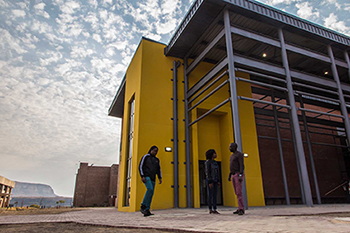New building on UFS Qwaqwa Campus makes provision for research on environmental problems

The new Geography and Physics Building on the Qwaqwa Campus |
Student numbers in Geography and Physics on the Qwaqwa Campus of the University of the Free State have escalated over the past five years. This has resulted in a need for more space for these two departments.
The acute and persistent shortage of lecturing space has been a major stumbling block on the campus, with only four of the Natural Sciences departments - Chemistry, Physics, Plant Sciences, and Zoology and Entomology – able to fit into the Natural Sciences building. To solve the problem, a separate facility for both the Geography and the Physics departments was built.
The new complex, which includes lecture rooms, laboratories, and offices, places the Department of Physics on the ground floor because the weight of some of the laboratory equipment. The Department of Geography is on the first floor.
The Department of Geography places strong emphasis on montane research. Research is being conducted on environmental problems in the Maluti-a-Phofung area. This research encompass in situ and ex situ conservation of paleontological resources, with the aim of setting up a GIS-based environmental management system, as well as the role of local cultures in promoting regional tourism.
The Department of Physics places emphasis on changing and improving community perceptions of electricity and electronics. The major part of the research has been in the field of solid-state physics, and, more specifically, on nanophosphors and other luminescent nanoparticles.
The building is in the north-eastern corner of the campus, opposite the Faculty of Natural and Agricultural Sciences.
The project was completed in 2015.